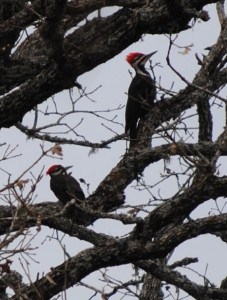Pileated Woodpecker
We always know when the Pileated Woodpecker is hungry. His distinct and resonant hammering sound is the loudest of the wood-pecking birds at Little Piney.
No matter how many times I see a Pileated Woodpecker, it’s always a thrill. At 15-19 inches tall, with a brilliant red crest, shiny black back, pure white breast and underwings, Pileated Woodpeckers are stunning birds even from a distance. Close up, they are even more handsome with dramatic red, white, and black faces. Their wingspan measures an impressive 29 inches.
Mr. and Mrs. P. Woodpecker

Pileated Woodpeckers are both monogamous and territorial; so chances are that the pair below, photographed last March, are the same birds that I photographed today. This species has been observed to live as long as 12 years.
Pileated couples work together. The female helps the male complete a large nest in a new location each year. Hollowed out of a large dead tree, the cavity measures up to 24 inches deep. A woodpecker cavity can always be identified by its rectangular shape. Each season the pair produces one brood of three to five chicks who stay with their parents until fall.
Ever wondered if Woodpeckers’ heads hurt? They have special sliding plates in their jaws that function as shock absorbers so that they can hammer away without getting concussions.
Short Video From Little Piney–Pileated Pair
http://https://www.youtube.com/watch?v=j2qA-0508CI
More About Pileated Woodpeckers
They are slightly smaller than crows, weigh as much as a cat, dine primarily on carpenter ants, and were once endangered species. Pileated Woodpeckers were the inspiration for Woody Woodpecker of cartoon fame.
Find out more about these charming birds at Pileated Woodpecker Central or All About Birds.





I loved reading this about the pileated woodpecker. I have them on my property and I am at the very end of the Lost Pines area between Smithville and La Grange, Texas but have thousands on my property. Pine trees, not woodpeckers!
ha ha
I just found out today what was making that beautiful bird noise that I’ve been hearing a lot of.
Hi Connie, You’re in a great location! You probably have all of the Woodpecker species native to Bastrop County–maybe even a Red-headed Woodpecker! Thanks for visiting Lost Pines Life!